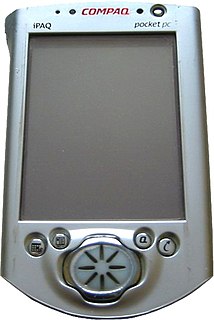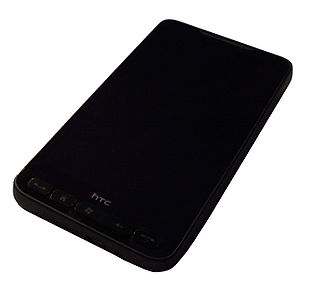Related Research Articles

A Pocket PC is a class of personal digital assistant (PDA) that runs the Windows Mobile or Windows Embedded Compact operating system that has some of the abilities of modern desktop PCs. The name was introduced by Microsoft in 2000 as a rebranding of the Palm-size PC category. Some of these devices also had integrated phone and data capabilities, which were called Pocket PC Phone Edition or simply "Smartphone".

Palm was a line of personal digital assistants (PDAs) and mobile phones developed by California-based Palm, Inc., originally called Palm Computing, Inc. Palm devices are often remembered as "the first wildly popular handheld computers," responsible for ushering in the smartphone era.

The iPAQ is a Pocket PC and personal digital assistant, first unveiled by Compaq in April 2000; the name was borrowed from Compaq's earlier iPAQ Desktop Personal Computers. Since Hewlett-Packard's acquisition of Compaq, the product has been marketed by HP. The devices use a Windows Mobile interface. In addition to this, there are several Linux distributions that will also operate on some of these devices. Earlier units were modular. "Sleeve" accessories, technically called jackets, which slide around the unit and add functionality such as a card reader, wireless networking, GPS, and even extra batteries were used. Later versions of iPAQs have most of these features integrated into the base device itself, some including GPRS mobile telephony.
Windows Embedded Compact, formerly Windows Embedded CE, Windows Powered and Windows CE, was an operating system subfamily developed by Microsoft as part of its Windows Embedded family of products.
The Motorola MPx200 Smartphone was launched in December 2003 as a joint venture between Motorola and Microsoft. The mobile phone's Windows Mobile for Smartphone OS allows users to access email and the Internet, use MSN Messenger, and view documents in Microsoft Office formats much like other Windows smartphones such as the Samsung SGH-i600 or HTC Tanager. The MPx200, along with the Samsung SCH-i600, were the first Windows Mobile smartphone devices to have wide distribution in the United States. Previously, smartphone platform devices could only be purchased in the United States as part of development kits sold by Microsoft. The only U.S. carrier of the phone was AT&T Wireless; however, reports also suggest a somewhat limited number of devices with Cingular branding have appeared following the purchase of AT&T Wireless by Cingular.

Sendo was a British manufacturer and supplier of mobile phones founded in 1998 and based in Birmingham. The company went into administration in June 2005 and its technology was bought by Motorola.
Windows Mobile is a discontinued family of mobile operating systems developed by Microsoft for smartphones and personal digital assistants.
Internet Explorer Mobile is a discontinued mobile browser developed by Microsoft, based on versions of the MSHTML (Trident) layout engine. IE Mobile comes loaded by default with Windows Phone and Windows CE. Later versions of Internet Explorer Mobile are based on the desktop version of Internet Explorer. Older versions however, called Pocket Internet Explorer, are not based on the same layout engine.

The HTC Apache is a Windows Mobile 5.0 device, sold as the PPC-6700 by Sprint, and the XV6700 by Verizon Wireless and other US carriers. The device was one of the first CDMA Windows Mobile 5.0 devices on the market, and the first to be released in the United States. The Apache is a Pocket PC PDA with smartphone capabilities.

i-mate is a company selling Windows Mobile-powered devices. The Group was launched by James Morrison, who began his telecoms career at sea designing and installing fiber optic cable systems with Cable & Wireless and was head of the team at O2 that designed the first O2 Xda Pocket PC phone and started Microsoft in the mobile software industry. He also selected HTC to be the OEM for the O2 XDA and started them in the mobile handset manufacturing business. He set up i-mate in Glasgow, Scotland in 2001 to deliver into the corporate market place. imate used HTC as their manufacturing partner for 22 handsets, It was based in Dubai, United Arab Emirates, and operated in the UK, Italy, Armenia, Australia, India, the U.S. and South Africa. Imate went on the London AIM Stock Market in November 2005 with a valuation of $350 million at flotation a climbed to a value of $989 Million in 2006, The company closed most of its business in September 2009.

Windows Mobile 6, formerly codenamed "Crossbow", was the version of Windows Mobile released on February 12, 2007 at the 3GSM World Congress 2007. It comes in three different versions: "Windows Mobile 6 Standard" for Smartphones, "Windows Mobile 6 Professional" for Pocket PCs with phone functionality, and "Windows Mobile 6 Classic" for Pocket PCs without cellular radios.
A mobile operating system is an operating system for mobile phones, tablets, smartwatches, 2-in-1 PCs, smart speakers, or other mobile devices. While computers such as typical laptops are 'mobile', the operating systems used on them are generally not considered mobile ones, as they were originally designed for desktop computers that historically did not have or need specific mobile features. This line distinguishing mobile and other forms has become blurred in recent years, this is due to the fact that newer devices have become smaller and more mobile unlike hardware of the past. Key notabilities blurring this line are the introduction of tablet computers and light-weight laptops.

Windows Phone (WP) is a discontinued family of mobile operating systems developed by Microsoft for smartphones as the replacement successor to Windows Mobile and Zune. Windows Phone featured a new user interface derived from the Metro design language. Unlike Windows Mobile, it was primarily aimed at the consumer market rather than the enterprise market.

Windows Mobile 6.1 was a version of the Windows Mobile operating system, released on April 1, 2008. It is a minor upgrade to the Windows Mobile 6 platform with various performance enhancements and a redesigned Home screen featuring horizontal tiles that expand on clicking to display more information, although this new home screen is featured only on Windows Mobile Standard edition. This was not supported in the Professional edition. Several other changes such as threaded SMS, full page zooming in Internet Explorer and 'Domain Enroll' were also added, along with a "mobile" version of the Microsoft OneNote program and an interactive "Getting Started" wizard. Domain Enroll is functionality to connect the device to System Center Mobile Device Manager 2008, a product to manage mobile devices. The most apparent of the other differences is that the Standard version still creates automatic links for telephone numbers in Tasks and Appointments, which allows for the easier click and dial of stored telephone numbers within these Outlook items. This feature is not supported in the Professional version. Windows Mobile 6.1 also had improved bandwidth efficiency in its push-email protocol "Activesync" of "up to 40.02%"; this considerably improved battery life in many devices.

The HTC HD2, is a smartphone in the HTC Touch family designed and manufactured by HTC. The HD2 natively runs the Windows Mobile 6.5 operating system, and was released in Europe in November 2009, in Hong Kong in December 2009, and in other regions including North America in March 2010. The phone is the successor to the HTC Touch HD, and is succeeded by the HTC HD7.

The Post-PC era is a market trend observed during the late 2000s and early 2010s involving a decline in the sales of personal computers (PCs) in favor of post-PC devices; which include mobile devices such as smartphones and tablet computers as well as other mobile computers such as wearable and ubiquitous ones. These devices emphasize portability and connectivity, including the use of cloud-based services, more focused "apps" to perform tasks, and the ability to synchronize information between multiple devices seamlessly.

Windows 10 Mobile is a discontinued mobile operating system developed by Microsoft. First released in 2015, it is a successor to Windows Phone 8.1, but was marketed by Microsoft as being an edition of its PC operating system Windows 10.

Pocket PC 2000 was the first member of the Windows Mobile family of mobile operating systems that was released on April 19, 2000, and was based on Windows CE 3.0. It is the successor to the operating system aboard Palm-size PCs. Backwards compatibility was retained with such Palm-size PC applications.

Windows Camera is an image and video capture utility included with the most recent versions of Windows and its mobile counterpart. It has been around on Windows-based mobile devices since camera hardware was included on those devices and was introduced on Windows PCs with Windows 8, providing users for the first time a first-party built-in camera that could interact with webcam hardware. It is similar in structure and features to the iOS and Android Camera apps.
Pocket-sized computer describes the post-programmable calculator / pre-smartphone pocket-sized portable-office hardware devices that included the earlier DOS-based palmtops and subsequent Windows-CE handhelds, as well as a few other terms, primarily covering the 1980s through 2007.
References
- ↑ "Sendo, Microsoft and HTC - the mysteries just grow- the Inquirer". www.theinquirer.net. Archived from the original on 5 March 2016. Retrieved 14 January 2022.
- ↑ "Sendo, Microsoft and HTC - the mysteries just grow- the Inquirer". www.theinquirer.net. Archived from the original on 5 March 2016. Retrieved 14 January 2022.
- ↑ Mobile Phones|Smartphone - Software Features Overview. Microsoft. Retrieved 6 September 2007 from the Internet Archive.